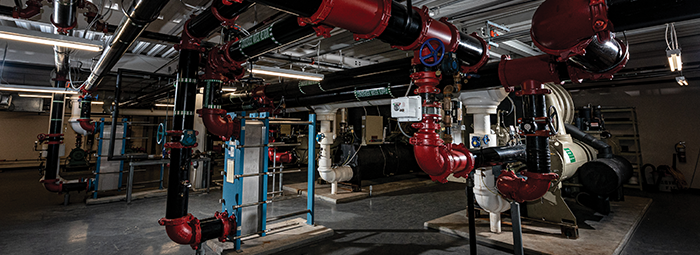
©2020 This excerpt taken from the article of the same name which appeared in ASHRAE Journal, vol. 62, no. 8, August 2020.
About the Authors
Kelley Whalen is facilities supervisor–energy management, HVAC & Electrical at ADTRAN. Jason Brooks, P.E., is director, engineering, and Eric Mobley is energy engineer at Sain Engineering Associates, Inc.
The ADTRAN East Tower in Huntsville, Ala., used several optimization methods to radically reduce energy use without costly equipment replacements. The project was completed without any capital expenditures; all results were gained strictly from modifications to the existing equipment and controls to increase efficiency. These methods saved over $71,326 annually in energy costs with a simple payback of 1.86 years.
The chiller plant consists of three 440 ton (1547 kW) chillers, three 490 ton (1723 kW) cooling towers, three constant volume chilled water pumps, three condenser constant water pumps, two heat exchangers, four auxiliary pumps, and one water heater.
Energy Efficiency
At the beginning of the project, ADTRAN was consuming 28,390,000 kWh annually on a campus level, which is comprised of three towers that occupy 1.04 million ft2 (96 619 m2). The East Tower, which accounts for 640,000 ft2 (59 458 m2) of the total footprint (slightly over 60%) consumes about 60% of that total use. Changes implemented in this project are saving ADTRAN over 950,000 kWh annually in energy consumption from just targeting the chilled water plant that serves the East Tower.
The savings are based on measurement and verification of data gathered over several years of building automation system (BAS) data and actual power meter data from ADTRAN and the engineering company’s power loggers for over 10 months. Using regression analysis and engineering calculations on trended and measured data, savings were determined (see Cost Effectiveness section).
In addition to these savings, changes have been implemented, achieving the following:
Increased business continuity from changes that make it unnecessary for ADTRAN to run more than two chillers, which also creates another layer of redundancy in the system if a chiller goes down.
Proper cooling of the East Tower D-Wing, which has historically had issues with cooling, through changing the system to allow more water flow.
Given that this project was completed without any capital expenditures, all results were gained strictly from modifications to the existing equipment and controls that increased efficiency.
Existing Operation Before This Retrocommissioning Project
In 2005, ADTRAN created an energy program, and since then hundreds of ECMs and many retrocommissioning (RCx) projects had already taken care of the low-hanging fruit.
Below are highlights of activities that took place under this retrocommissioning project:
Trended over 300 points pertaining to the plant in one-minute time intervals, capturing over 131 million readings using the BAS, which aided in analysis of the plant’s current operation and aided in monitoring as changes were made.
Installed four power loggers/analyzers capturing over two million power consumption readings over 10 months. This data is used for measurement and verification of savings calculations. Virtually all the equipment in the building was monitored including chillers, pumps, cooling towers and air-handlers. Space temperatures and water temperatures are also trended.
Read the Full Article
ASHRAE Members have free access to the full-text PDF of this article as well as the complete ASHRAE Journal archives back to 1997 in the Free Member Access Area.
Non-members can purchase features from the ASHRAE Bookstore. Or, Join ASHRAE!
Return to Featured Article Excerpts
Return to ASHRAE Journal Featured Article Excerpts